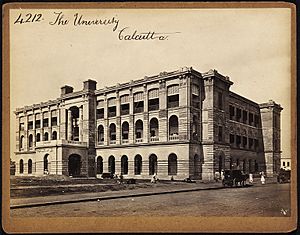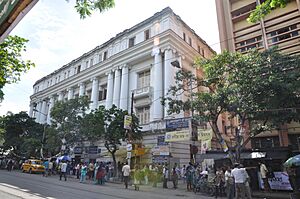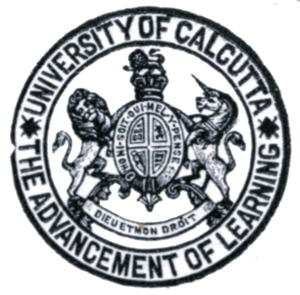History of the University of Calcutta facts for kids
The University of Calcutta is one of India's oldest and most famous universities. It was founded in 1857 and has a long, interesting history. Many important scientists, thinkers, and leaders have been part of this university.
Contents
Early Years (1857–1947)
Starting the University
The University of Calcutta officially began in 1857. Before that, a British official named Dr. Fredrick John suggested starting a university in Calcutta. He wanted it to be like the University of London. At first, the idea didn't get approved.
But in 1854, a plan to create two universities was accepted. One would be in Calcutta and the other in Bombay. This decision came from an important document called Wood's despatch. The Calcutta University Act became law on January 24, 1857.
A group of 41 people, called the Senate, was formed. They were in charge of making decisions for the university. When it first opened, the university covered a huge area. It stretched from Lahore (now in Pakistan) to Rangoon (now in Myanmar). This was the largest area for any Indian university at the time.
First Steps and Growth
The university's main committee, the Syndicate, started working on January 30, 1858. The first meeting of the Senate happened at the Calcutta Medical College. The university's first office was in some rented rooms on Camac Street. For many years, meetings were held at the Writers' building.
In March 1861, the first entrance exam was held. About 244 students took the test at the Town Hall of Calcutta.

The first head of the university, called the Chancellor, was Governor General Lord Canning. The first Vice-Chancellor was Sir William Colvile. In 1858, Joddu Nath Bose and Bankim Chandra Chatterjee became the first students to graduate from the university.
From 1860 to 1890, Government Science College, Jabalpur, which was India's first science college, was connected to the University of Calcutta.
In 1862, the university decided to build its own main building. The historic Senate Hall was built and opened on March 12, 1873. The university library also started soon after.
Important Developments (1900-1947)
In 1914, the Rajabazar Science College was created. In 1917, a new system for advanced studies and research was started. The Asutosh building opened in 1926. The Asutosh Museum of Indian Art began in 1937.
In 1937, when Dr. Syamaprasad Mookerjee was the Vice-Chancellor, he asked the famous poet Rabindranath Tagore to write a song for the university. Tagore wrote two songs. The second song, Subho Karmapathe Dharo Nirvayo Gaan, was chosen as the university's official song.
The Institute of Nuclear Physics was founded in 1945. It was the first of its kind in Asia, started by scientist Meghnad Saha.
After Independence (1947–Present)
In 2001, the University of Calcutta received a 'Five Star' rating. This was from the National Assessment and Accreditation Council (NAAC), which checks how good universities are. In 2009 and 2017, the NAAC gave the university its highest grade, 'A'.
In 2019, the university's main library and its 40 smaller departmental libraries were opened for everyone to use, not just students.
University Seals
A university seal is like its official logo or emblem. The University of Calcutta has had several seals over the years.
The first seal was used when the university was founded in 1857. At that time, India was ruled by the British East India Company.
The second seal was adopted after the British government took direct control of India. This seal showed a lion and a crown, representing the British Raj. It also had a lion and a unicorn, and the Latin motto Dieu et mon droit (meaning "God and my right").
The third seal was used for a short time in 1930. It showed three elephants carrying a book.
The fourth, fifth, and sixth seals looked very similar to each other. They all featured lotuses, which are important symbols in India.
The seventh seal is the one the university uses today.
See also
 In Spanish: Universidad de Calcuta para niños
In Spanish: Universidad de Calcuta para niños



